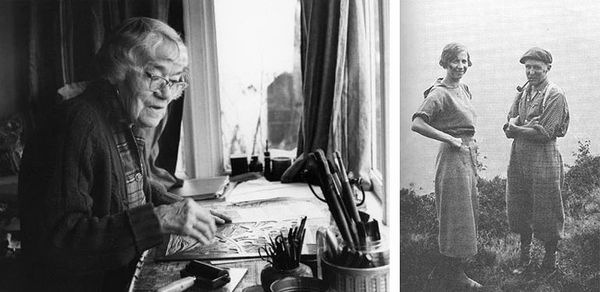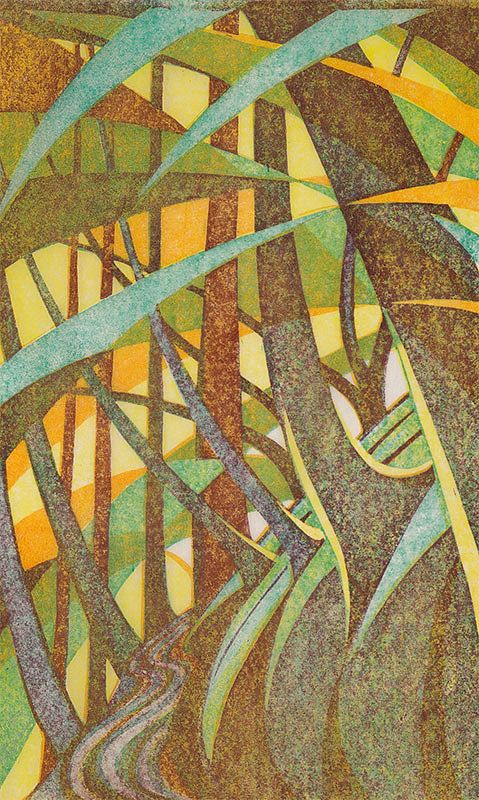Sybil Andrews, The Windmill (C. SA 27), 1933. Editions London.
From 1925 to 1940, The Grosvenor School of Modern Art served as an influential artistic hub during the inter-war years. Founded by Iain Macnab, the school ran numerous classes out of Macnab’s Pimlico residence in London. As part of the informal curriculum, the British artist Claude Flight taught a class focused on the linoleum cut technique. His most notable pupils were Cyril Power, Sybil Andrews, and the Swiss-born artist Lill Tschudi. Together, they became known as the Grosvenor School and were the driving force behind the revival of linoleum cut printmaking in Britain – a medium they viewed as democratic due to its affordability to produce and its lack of prior representation in the art historical canon. As a group, the Grosvenor School artists focused on depicting modern life in an aesthetic influenced by pre-war movements such as Futurism, Cubism and Vorticism. In doing so, they aimed to create a new art that was representative of a new age.

Left: Sybil Andrews in her studio, circa 1980. Right: Lill Tschudi and Claude Flight, 1933. Image: © Estate of Lill Tschudi.
Best known for her modernist linocuts, Sybil Andrews’ The Winch (1930) encapsulates a primary focus of the Grosvenor School artists: industrial Britain. Military Conscription for young men during the First World War led to women being recruited into traditionally male jobs, and it was as an apprentice welder working on the first all-metal airplanes that Andrews was exposed to industrial labor. In The Winch, Andrews depicts two men manually operating a piece of machinery in unison. The centrifugal composition appears to rotate around the focal point of the winch, creating the impression of movement and capturing the unrelenting rhythm of industrial labor. Uniformly dressed and with no facial features, the two anonymous men seemingly bend to the forces of the machine’s surrounding vortex. There is a mechanized quality to the bodies of the two men: an example of Andrews’ interest in the relationship between man and the machine, which permeates several of her linocuts. Although not explicitly political or critical, The Winch is not entirely celebratory of the rapid industrialization taking place in Britain. Instead, there are hints of an underlying anxiety about the vast technological advancements of the time, which certainly existed in a society still reeling from the effects of the First World War.

Sybil Andrews, The Winch, 1930. Editions London.
It was not just images of modernity and urban life that served as subject matter for the Grosvenor School artists. The Windmill (1933) is a depiction of Elmers Mill, situated near to Andrews’ birthplace, Bury St Edmunds. The center of the windmill’s sails forms the point from which the rest of the composition appears to rotate, once again creating a sense of dynamism. This more traditional and rural focus presents a nostalgia for a pre-industrial, slower paced life. The rotating sails of the windmill allude to the power of nature in a cultural moment when technology was being glorified. Yet, the Grosvenor School were keen to create an aesthetic that could represent everyday British life in all its forms. By applying their Modernist aesthetic to a range of subject matter, Andrews demonstrates the diversity and possibilities of the linocut medium.

Lill Tschudi, In the Circus, 1932. Editions London.
The Grosvenor School artists also used popular leisure activities of the time as inspiration for their prints. As London and its suburbs grew, so did the opportunities for entertainment. Concert halls, fairgrounds and the circus featured prominently in the artists’ works – the latter exemplified in Lill Tschudi’s 1932 print In the Circus. Tschudi’s interest in speed and movement come to the fore in this image. Depicting three figures swinging on a horizontal bar, it is unclear if these are indeed three individuals or if, instead, Tschudi is attempting to convey snapshots of one figure’s rotations on the bar in a composition inspired by the photography of Eadweard Muybridge. Four graphic streaks representing spotlights also emphasise the careful process of layering colors to create depth, highlights, and shadows in this print. Tschudi’s simplified geometric forms with vibrant colors speak to the dynamism and vitality of modern life in Britain which the Grosvenor School artists sought to convey.

Sybil Andrews, Trackway/Piste (C. SA 61), 1961. Editions London.
Linocuts remained the favoured medium of both Lill Tschudi and Sybil Andrews well beyond the inter-war years. While Tschudi returned to her native Switzerland in 1935, she worked prolifically, producing over 300 linocuts in her life which moved gradually towards abstraction. Sybil Andrews also left Britain, emigrating to Canada in 1947 and settling in the logging community of Campbell River on Vancouver Island. Inspired by the dramatic landscape of British Columbia, many of her subsequent linocuts reflected this new environment. Trackway/Piste (1961) depicts logging tracks through dense forest on a steep incline. The careful layering of four bold colors creates a graphic and dynamic composition reminiscent of her earlier creations. Once again marrying a more traditional, rural subject matter with her Modernist aesthetic, Andrews demonstrates the versatility and longevity of the Grosvenor School’s style.
Recommended Reading
